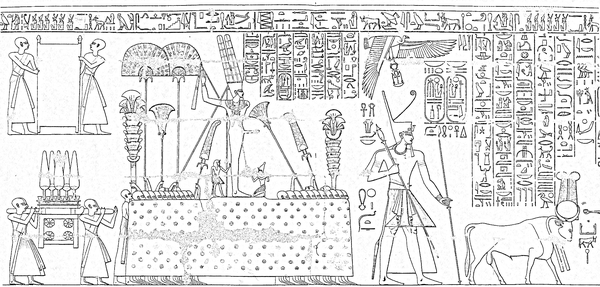The cult of Min, the god of fertility and harvest, has been known since the predynastic period. Centres of Min veneration were located in Qift and Akhmim (Panopolis), where festivals of that god took place. On the Palermo Stone (mid-V dynasty), the festival of mswt Mnw (‘birth’ or ‘creation of the statue of Min’) is mentioned — possibly, it was identified with the later festival of prt Mnw (‘Min Coming’), celebrated on the new moon of the month of Pakhon (the first month of the season of harvesting). The most detailed description of the festival could be found in reliefs of the Theban temples of Ramesses II in the Ramesseum (XIX dynasty) and Ramesses III in Medinet Habu (XX dynasty). There is another name of the festival in the texts commenting the scenes: ‘Coming of Min to xtyw’ (prt Mnw r xtyw).
The central rite of the festival was setting a statue of the god on the stepped pedestal-xtyw, a symbol of the initial hill or garden. The meaning of the festival was in the renovation of the authority and power of the ruling king, that made it close to the Heb Sed. Symbolism of the festival rituals was also associated with the myth on the daily navigation of the solar god along the heavens, with the sunset on the western horizon and the resurrection at the sunrise. One more aspect of the festival was connected to the funeral cult, with the concepts of death and resurrection of a deceased in the afterworld. In that sense, the festival was connected to the Osiriac festivals of the month of Hoiak.
Studying the reliefs of the temple in Medinet Habu allows classify six episodes of the festival. At dawn of the day of the new moon, a procession went out of the palace and headed to the temple, from which priests brought out the statue of Min — then, they went to the sanctuary-xtyw. In the evening, there was the rite of setting a statue of the god on the pedestal-xtyw; the king came into the sanctuary to held a ceremony of sacrifice and cutting a sheaf; then, he left the sanctuary and made a circumambulation of it. At dawn of the second day of the lunar month, the rite of setting the supporting pole of the sanctuary-sHnt took place. After it, there were coronation ceremonies of the ruler, shooting four arrows to the sides of the world and releasing four birds.
 A procession of priests bringing the statue of Min. Relief from the temple of Ramesses III In Medinet Habu (drawing)
A procession of priests bringing the statue of Min. Relief from the temple of Ramesses III In Medinet Habu (drawing)
(Medinet Habu 1940, pl. 201)
Bibliography
-
Bleeker C. J. Die Geburt eines Gottes. Eine Studie über den ägyptischen Gott Min und sein Fest. Leiden, 1956.
-
Gauthier H. Les fêtes du dieu Min. Le Caire, 1931.
-
Medinet Habu. Festival Scenes of Ramses III / Eds. J.A. Wilson, T.G. Allen. Vol. IV (OIP, 51). Chicago, 1940.
-
Moens M.-F. The Procession of the God Min to the xtyw-Garden // SAK. 1985. Bd. 12. P. 61–73.
-
Mironova A.V. Prazdnik ‘Vykhoda Mina’ v reliefakh khramov Novogo Tsarstva: problema prochteniya i interpretatsii (The ‘Min Coming’ Festival in the reliefs of the temples of the New Kingdom: a problem of reading and interpretation) // Vestnik drevnei istorii. 2013. Iss 3. P. 108–124.
Tags: Ancient Egypt, Alexandra V. Mironova, Articles, Festivals

 English (United Kingdom)
English (United Kingdom)  Russian (Russia)
Russian (Russia)